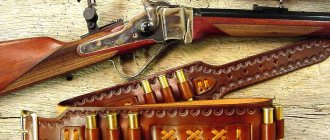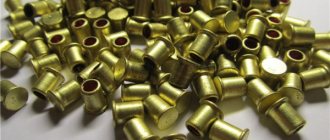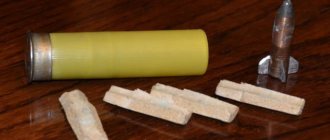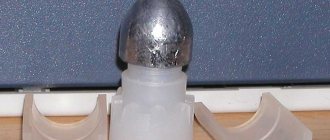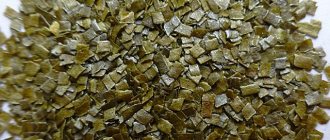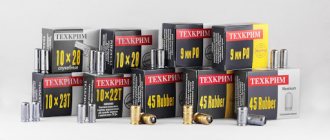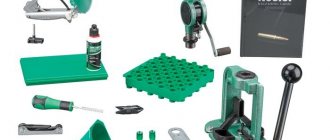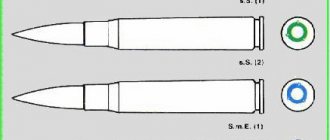The primer (primer-igniter) is a small metal cap containing certain chemicals inside which, when the firing pin hits the primer, ignite and thereby ignite the powder charge, which leads to a shot.
It is important to note that the primer not only ignites the powder charge, but also creates increased pressure and temperature in the cartridge case, which promotes good combustion of the powder.
The capsule is made of soft metal, most often brass, copper or alloys of copper and aluminum. The shock composition is a mixture of chemicals, most often Berthollet salt, mercury fulminate and antimonium. Each substance included in the percussion composition of the primer has its own role: Berthollet salt gives a flash, antimony burns, and mercury fulminate provides the oxygen necessary for combustion in the closed chamber of the cartridge.
The history of the modern capsule begins in the 18th century in France, when the French chemist Boyenne discovered mercury fulminate in 1784, and his compatriot Berthollet discovered berthollet salt in 1788.
The first open-type metal capsule was created in 1814 by the American D. Shaw.
Already at the end of the 19th century, a closed capsule with an internal anvil of the “Zhevelo” type was created in France.
There are two types of primers used by hunters these days: open imp primers and closed imp primers.
What are the consequences of choosing the wrong capsule?
A novice hunter may well think - what difference does it make which capsule to use? After all, the main thing is that it ignites the gunpowder. And the rest will go like clockwork. Alas, in reality this is not the case at all. And when hunting for such a mistake, you can easily pay not only with spoiled pleasure, but also with your life. An unsuitable capsule often leads to very disastrous consequences. If you choose a primer that is too weak, it will not be able to ignite the powder immediately (linger shot). Too much pressure creates excess pressure, which can cause the cartridge case to explode or at least swell. Why is a long shot dangerous? High pressure is not created in the powder chamber, guaranteeing instant combustion of the powder. And the hunter, having pulled the trigger, does not feel the usual recoil and does not hear the shot. Often, beginners perceive this as a misfire and take the weapon away from their shoulder, and sometimes even break the gun to remove the damaged cartridge. Gunpowder, while not burning instantly, still detonates. Troubles in this case can be very different - from a broken collarbone (if the butt is pressed weakly and incorrectly) to a burn to the face (if gunpowder that flared up late throws a cartridge case into the face from a broken gun). You don’t have to say what the risks of hunting are, especially if you are going to hunt not only duck and hare, but also wild boar, elk or bear. In this case, the smallest mistake can cost the hunter his life. So, you should approach loading hunting cartridges as seriously as possible. Remember - not only your pleasure, but also your safety depends on this! Now let's talk about what capsules can be like. Today, the most common in our country are centrifuge and zhevelo. And we should talk about them in more detail.
Primer flammability
The flammability of Zhevelo (also known as primer power) is one of the determining parameters. This is due to the fact that gunpowder is a finicky substance, and in order for it to burn well, it requires fire with a certain strength and duration of burning, otherwise a misfire or a prolonged shot will occur.
Misfire is considered the most annoying phenomenon for hunters. However, what many people don't take into account is that a long shot is much more dangerous, since the loaded cartridge can fire even after the bolt is opened. The parameters indicated above (burning duration and its strength) are called flame force. At the same time, a primer with an excessively powerful flame force will not improve ballistic characteristics. It will only create excessive pressure in the barrel and, as a result, lead to damage, deformation or even destruction of the barrel.
However, even with a correctly selected primer, combustion products will settle on the barrel of the gun and have a so-called rusting effect. Therefore, it is recommended to clean your guns immediately after hunting.
How does the rusting action occur?
After the explosion, the impact composition decomposes, forming solid, gaseous and vaporous combustion products. They settle on the barrel and are knocked out after the next shot. Let's take a closer look at them:
- Potassium chloride. It greatly damages the crystal lattice of metals; after such exposure, the barrel becomes less resistant to temperature changes.
- Melting, the particles remaining during combustion will be ejected from the barrel by gases formed after igniting the gunpowder. Micropotholes remain where they were. This is where the particles of potassium chloride settle. These particles attract moisture, which causes the barrels to rust and the weapon to become unusable faster.
- Metallic mercury, turning into a gaseous state, seeps directly into the structure of the metal that makes up the barrel and provokes cracking of the metal. This causes the barrel of the weapon to become deformed or destroyed.
However, such a negative effect can be avoided. For this purpose, in 1989 she invented and patented special capsules of the Zhevelo-N type. This abbreviation stands for “Jewish-non-rusting”. The composition that ensures the ignition of gunpowder includes elements such as barium nitrite, aluminum powder and lead trinitroresorcinate. These components reduce the negative impact of combustion products on the barrel of a weapon. However, it is worth remembering that this will not completely neutralize the negative impact of combustion products on the bore. Therefore, after hunting, the gun barrels still need to be cleaned, and it is strictly prohibited to shoot only with primers (even for the purpose of the so-called “check” of the primer for flame force).
Good old centrifuge
Capsule Centrifuge
This type of capsule has been around for a very, very long time. Initially, it was used with smoke gunpowder, which ignited much faster and easier than modern, smokeless gunpowder (be it Falcon or Bars). The centrifugal device has the simplest possible design. The shallow cap contains a grain of the shock composition. On top it is protected by a layer of foil, which is secured with varnish. For the centrifuge to explode, igniting the gunpowder, the impactor must be compressed between two solid objects. One of them is the firing pin, and the second is a special protrusion (anvil) in brass cartridges. The main advantage that the centrifuge can boast of is its low cost. Of course, equipping hunting cartridges with its help is cheaper. Unfortunately, this comes at the price of reduced reliability. The centrifuge fails much more often than the chewing rod. The cause of a misfire can be not only a manufacturing defect, but also a strong shock. Do not forget about the structural features of the sleeves. There are tiny holes in the base of the brass cartridges designed for this primer - it is through them that the powder ignites. However, with regular use, powder carbon deposits can clog these holes (they are very small, no more than 1 millimeter). Of course, if the hole is clogged, the gunpowder may not ignite or may not ignite sharply enough. This leads to either a misfire or a prolonged shot. Therefore, after removing the used capsule, the anvil and holes are cleaned with an awl or other thin and sharp object. In addition, this primer is poorly suited for igniting smokeless powder. To compensate for this, experienced hunters add a pinch of black powder to the cartridge case, and only then - the norm of black powder. Black powder, igniting instantly, also ignites smokeless powder, which contributes to a powerful shot.
What to say about the centrifuge
But the popularity of the centrifugal type igniter among fans of smooth-bore weapons is falling. Despite its simplicity and cheapness, it cannot provide such fast and powerful combustion of gunpowder, so the demand for it is decreasing. But the use of a centrifuge in cartridges for rifled weapons ensures that it will not disappear very soon. Even a 7.62 caliber cartridge, not to mention a 5.56 caliber, contains much less gunpowder than, for example, a 12 or 16 gauge. Therefore, the centrifugal capsule works great here.
The analogue of the Boxer system is very similar to the centrifugal capsule - having exactly the same device, they differ only in the absence of a positioning welt. But these samples are used mainly in the USA, where self-loading of cartridges for rifled weapons is legal.
Of course, if we list all types of igniter primers by number, it would take another article. But what has already been said is enough for the reader to get an idea of this complex, but integral component of a modern cartridge.
Is it possible to replace the centrifuge with a chewel and vice versa?
Some not very experienced hunters, who have never loaded hunting cartridges on their own, and who decided to take on such a difficult task for the first time, do not think about matching the primers with the cartridge cases. They believe that there is a sleeve and there is a primer. In this case, the dimensions of the hole are quite consistent with the dimensions of the capsule. So why not combine them? However, this may seem so only at first glance. If you look a little more closely, you can easily identify certain inconsistencies. To begin with, the height of the centrifugal cylinder is no more than 2-3 millimeters, while the height of the chewed rod is no less than 4-5 millimeters. In addition, the design of case bases designed to use different primers varies significantly. Brass sleeves, equipped with a centrifuge, as mentioned above, have a special anvil, at the base of which there are two small holes. The striking compound is pressed against the anvil, after which a powerful blow from the striker ignites it. Fire, penetrating through the holes, ignites the gunpowder, which ejects a charge (bullet, shot or buckshot). In this case, the pressure in the powder compartment is created relatively weak - no more than 19 kgf/cm2. This is quite enough for black powder to flare up and burn out in a fraction of a second. But plastic and paper cartridges (however, the latter are not on sale today), used with a Zhevelo capsule, have a simpler structure (thanks to the more complex structure of the capsule itself). There is simply a hole at the base of the cartridge case - no anvil or holes for flame penetration. The capsule is placed in this hole. Unlike a smooth centrifuge, the zhevelo has noticeable protrusions on the lower part of the body, which rest against the edges of the hole on the sleeve, securely locking into the socket. The firing pin hits the primer in the same way, after which the striking composition ignites. Special components made it possible to make the capsule more sensitive - approximately 2.5 times compared to the centrifuge. This reduces the risk of misfires. The flame from the primer passes to the gunpowder not through tiny holes, but through one large one. This, combined with the increased power of the impact composition, allows you to create a pressure of 42 kgf/cm2 (compared to 19 for the centrifugal!). In addition, the flame in this case turns out to be longer. This promotes instant ignition of smokeless powder. As a result, a powerful shot thunders, sending a charge over a huge distance.
Types of Zhevelo
There are several types of Zhevelo, such as:
- Zhevelo
- Zhevelo-N
- Zhevelo-M. The letter M stands for "Powerful". An increased impact charge is added to such primers.
Mainly on the domestic market there are capsules of the Zhevelo-N type from both domestic and foreign manufacturers.
Domestic models - KV-21, KV-22 and KV-209, which only recently entered production.
Of the imported ones, the most common are Italians - “Fiocchi-616” and “Mayonki-688”.
All these models have an extremely similar structure (caps with a flange with a diameter of 7.26 to 7.29 mm). A small hole is left on the top of the cylinder: open on the KV-21; closed with a paper gasket for the KV-22; and for the KV-209 and “Italians” it is filled with varnish.
Let's move on to the differences. Despite the fact that all capsules (KV-21i 22, KV-209, Fiokki-616 and Majonki-688) are of the same type, they cannot always replace each other. The KV-21 is the “patriarch” of Russian primers, the production of which began during the Soviet Union, and is not interchangeable as such. The remaining models are completely interchangeable.
They also differ in power. The KV-21 is rather weak, often misfires with pneumatics, and is only suitable for summer-autumn hunting. Its dimensions (and characteristics) completely coincide with Zhevelo, so 21 is suitable for any cartridges. And the open hole makes this KV-21 cartridge extremely sensitive to storage conditions.
Dimensions : base diameter 5.6 mm, height 7.6 mm, top hole diameter 4.5 mm.
KV-209, 22, “Fiokki” and “Mayonki” are usually compared with “Zhevelo-M”, and 22 and “Fiokki” will be a little weaker, and “Mayonki” and KV-209 will be a little more powerful.
Dimensions: diameter of KV-209 and 22 bases 6.2 mm, height 7.6 mm, top hole diameter 5.6 mm.
The KV-22 is also different in that many Saiga owners complain about misfires when using this particular type of primer. When using models similar to the KV-22 (209 or foreign), problems with misfires disappear, but the cause of such problems is still unknown.
“Italians” are very similar to their domestic counterparts, only slightly taller – 7.8 mm and have wider holes – 5.65 mm.
The shelf life (calculated from the time of manufacture) of capsules also varies greatly:
- TsBO and TsBO-N (which were discussed at the beginning of the article) – 3 years;
- Zhevelo-N - 6 years;
- Zhevelo-M - 3 years when stored in a sealed container and 1 year when stored in an unsealed container.
Some hunters say that if stored properly, the shelf life reaches 15 years. But you need to keep in mind that if you store primers for too long, they can lose their power, begin to misfire the cartridge, or lead to a delayed shot.
Models KV-21, 22 are sold in packs of 100 or 300 pcs. (open CBO type – 1000 pcs.) KV-209 are also sold in 200 pcs.
Conclusion
As you can see, despite its apparent simplicity, the capsule has a rather complex structure and a number of distinctive features that are useful to remember for both beginners and experienced hunters. Only in this case can you count not only on maximum safety for yourself, but also on rich booty.
Did you like it? Share on social networks!
We recommend reading
- How to load a 12 gauge cartridge
- Gunpowder Sunar weights and characteristics
- ← How to hunt a goose in the spring?
- Pheasant hunting: nuances you need to know →
Comments
- Dima 12/15/2015 at 12:11 Yeah.
If you haven't recharged it correctly, it will be very difficult to hit. Useful information for all hunters. Answer - Denis 12/15/2015 at 13:49
Now is the time to prepare ammunition for the spring season. I always try to load the cartridges myself, since I don’t really trust ready-made ones. With independent equipment, you can adjust both the weight of the shot charge and the weight of gunpowder. And I almost always use Zhevelo capsules. Somehow it turned out that I completely trust them.Answer
- Pavel 01/17/2016 at 04:32
I shot with a chewing gun instead of the usual center-fire. I’m very pleased with the result, the article is very interesting, it will help a beginner understand the basics of hunting!Answer
- Maxim 01/17/2016 at 11:54
Many people now use purchased cartridges, but self-loading has a special charm. The zhevelo is much more powerful than the centrifuge. The centrifugal effect used to be strengthened by adding a few grains of black powder to the bottom of the cartridge. Personally, I prefer shells; now there are metal sleeves for them.Answer
- Yuri 01/17/2016 at 16:42
Even after installing Zhevelo in the case, I fill it completely with black powder, then add the main gunpowder. The effect is very positive, even at minus 20*C it burns without a trace, the barrel shines after a shot, the accuracy and range of a lethal shot with shot increases.Answer
- Victor 01/25/2016 at 19:46
I have been loading cartridges for about 30 years. I use Sokol gunpowder from the USSR and now Russian, I have never added black powder under the Zhevelo primer in a way that is not recommended. The Zhevelo primer itself is more powerful than the Tsentroboy primer and its the power is enough to ignite the gunpowder. There were cases where I took a hare and a duck at a distance of about 100 meters, although I noticed that the gunpowder in the barrel did not seem to burn completely and the shot was effective. Shotgun IZH-54, piece, barrel length 750mm.Answer
Pilot Delta 12/14/2018 at 09:54
You can’t see a hare or a duck within 100 meters... let alone conduct targeted shooting at them (that is, shooting in your case) Science fiction writer, blah! ))))
Answer
Anonymous 12/21/2018 at 12:44
What kind of hunter are you that you won’t see an animal 100 meters away? Quite a real situation. I took the hare 120 steps. Saiga 20K shotgun.
Answer
WHAT ABOUT 7.62x54, charge 3.2g and CENTERBOY?
Answer
Half (if not more) is wild **** deja, not info. Yes, sometimes there are misfires, one in a thousand (here the sleeve may also be 50% to blame). The centrifuge lights up both Sokol, Sunar and Nobel perfectly. The main thing is that the metal case must be well sealed, and the projectile does not immediately take off, but allows the gunpowder to flare up (and create the so-called boost pressure)
Answer
One day, while hunting, my father let me shoot a crow with a self-rolling cartridge. He always charges them himself. The capsules were also chewed. The gun spat out shot about 20 meters away, along with gunpowder. I even saw her fly. The crow didn't even notice us. The father looked very puzzled. The primer did not ignite the gunpowder. He had never experienced anything like this in all 15 years of hunting. Half of the gunpowder then fell out of the barrel. Along with gaskets.
Answer
Add a comment
latest comments
Alexey: How can I order?...
Vladimir: The material is outdated and requires correction on two points: - described ...
Mikhail: Is it possible to make a module for Muscovite heels? How much will it cost …
Gennady: One person did something and everyone else should be responsible for it...
: If he opened fire within the city, then this is not a hunter, but a idiot...
Anatoly: In the requirements for documents for renewal, replace the psychologist with a psychologist...
YuryY: Having shot 1 can of gunpowder, Bars was very pleased with it, the factory weighed it...
Acorn: You understand so much...
: Vile degenerates! Bastard hunters, cowards, shoot yourself and that’s it...
Alexander: 35g, it’s simply impossible to stuff it into a pistol cartridge. People, for example...
Vladimtr: No, it’s not a typo, it says 35 g of Gunpowder per bullet weighing 7.45 g of gunpowder...
Evgeniy: It’s not clear. But for a state fee of 650 rubles, can I buy pheasant and...
Survey

